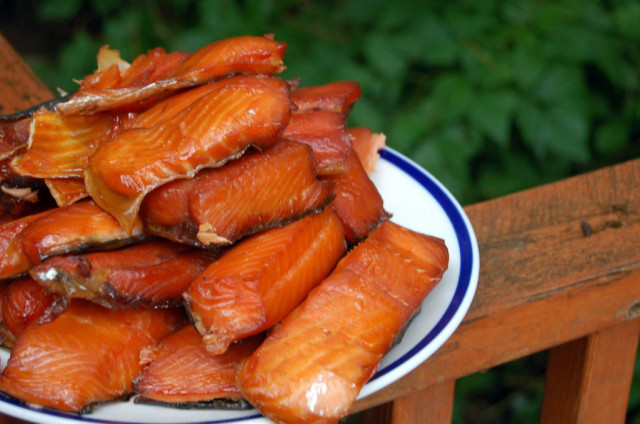 Bradley Smoker Smoked Salmon – Make Your Own Delicious Smoked Wild Salmon!
Bradley Smoker Smoked Salmon – Make Your Own Delicious Smoked Wild Salmon!
Salty Dog Boating News Brings you: Wild Smoked Salmon, Bradley Smoker Brining and Glazing: Brought to you by, Salty Dog Maritime Marketing, Salty Dog Boaters, Try This Recipe: Bradley Smoker Smoked Salmon. This Bradley Smoked Alaskan Salmon recipe gives you everything you need to know to cook up some of the finest salmon you’ve ever had, and also leaves room for you to experiment with your own favorite seasonings. You’re encouraged to add a little extra salt/sugar, perhaps some maple syrup, honey or peppers to give it a kick. When filleting your fish, be sure to leave the skin on and remove all bones. Remember it’s a special day, and that means it deserves cooking excellence!
Brine Ingredients:
- 1 gallon cold water
- 1 quart teriyaki OR soy sauce
- 1 cup pickling salt
- 2 lbs. brown sugar
- 2 Tbsp. garlic powder
- 3 Tbsp. cayenne pepper
Mix all ingredients in a non-metal container. Make sure that the salt and sugar is completely dissolved.

Preparing the Smoked Salmon
Step 1: Prepare the Fish
- Filet salmon with skin on.
- Carefully check each filet and REMOVE ALL BONES (Very important for excellence!). A small pair of clean needle nose pliers works well in removing any remaining bones that are stuck in the flesh.
Step 2: Cut into Strips
- Cut meat into uniform strips, 3/8″ to 1/2″ wide and 3″-6″ long, OR as long as your smoker racks can handle. The key here is to get uniform thickness cuts for uniform brining and smoking. The length is important only as far as your own packaging preferences. The strips will have a tendency to fall or sag through the larger grid racks, therefore it is best to use the Teflon coated jerky racks, a small grid (1/2″) teflon coated rack.
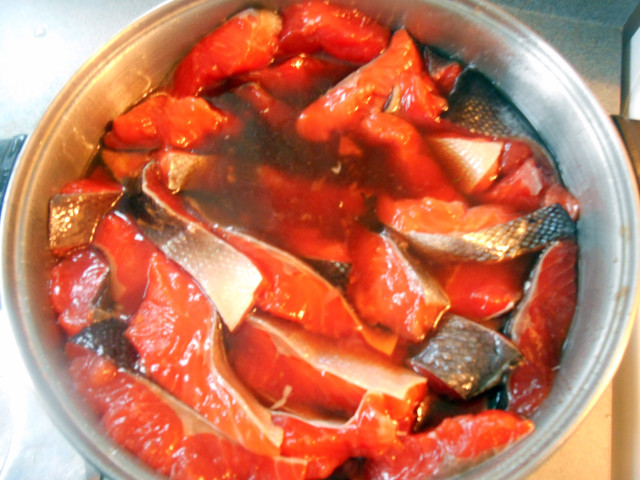 Cut Fish into Strips with Skin Left On
Cut Fish into Strips with Skin Left On
Step 3: Brining
- After preparing the brine, add salmon.
- Place a weighted stainless steel, wooden grate, or large plate over the top of the fish to hold it under the brine. Always keep the brine and fish cool. If you do not have enough refrigerator space, use an Igloo type ice chest with about a gallon of ice thrown in, and monitor the temperature to ensure that is stays below 40°F.
- Soak salmon in brine recipe for 12 hours, stirring the fish a few times during the brining process.
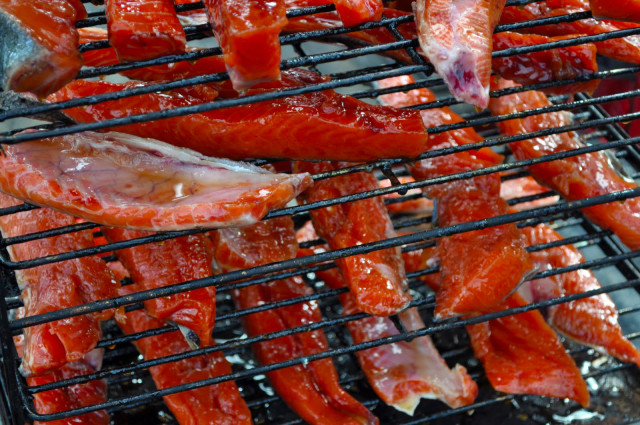 Coat Your Racks With a Non-Stick Spray Before Placing Fish
Coat Your Racks With a Non-Stick Spray Before Placing Fish
Step 4: Glazing
- Place fish in a single layer on Teflon coated jerky racks (coated with a non-stick cooking spray), or drying racks and ensure that the pieces DON’T touch each other.
- Air dry in the refrigerator until a hard pellicle forms. Fish will have a tough shiny coat and will be slightly tacky to the touch.
- Turn the fish over 2-3 times during the Glazing process to ensure more complete glazing. It is during the glazing process that you can sprinkle on certain spices (e.g. cayenne pepper) and/or visual enhancers (e.g. parsley flakes). (Winter time tip! Dry 12-36 hours in a cold place such as an unheated garage, but DON’T allow to freeze).
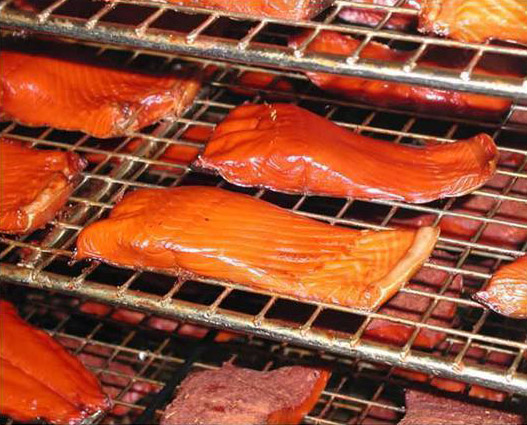 Turn Fish Over Several Times During Brining Process
Turn Fish Over Several Times During Brining Process
Step 5: Smoking
Smoke using the following Bradley Smoking guideline with alder, cherry, or apple bisquettes:
- 100°F – 120°F for 1-2 hours
- Increase to 140°F for 2-4 hours
- Increase to 175°F for 1-2 hours to finish
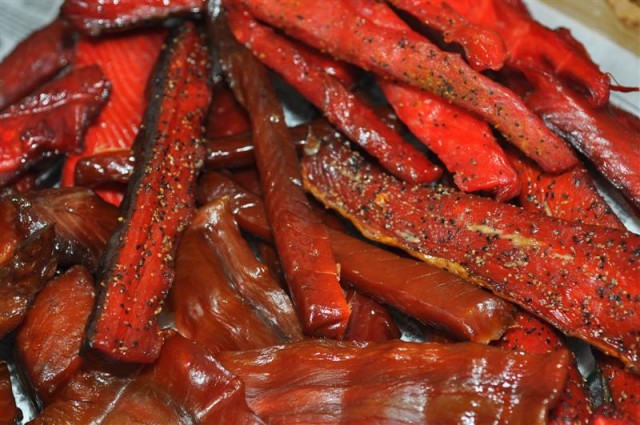 Enjoy Your Bounty of Delicious Smoked Wild Salmon!
Enjoy Your Bounty of Delicious Smoked Wild Salmon!
Notes:
Use the longer times given for thicker/higher oil content fish. As a general rule, the higher temp you use or the longer you hot smoke, the more the meat cooks the oils out, HOWEVER, the meat becomes dryer/tougher in the process.
The Bradley test kitchen has ‘accidentally’ left meat (silver salmon) at the 140°F – 150°F range for up to 8 hours and it still turned out great. They suggest that you’d have to try REAL hard to make a batch of smoked salmon unpalatable by over smoking/cooking. If you get white ‘boogers’ on the meat, you’re cooking too high/too fast.
Others that have used this recipe have applied smoke from 1.5-5 hours, depending on personal preferences. Most smokers are using 1.5-2 hours of smoke.
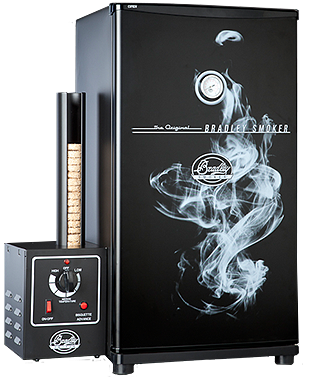
Tips and FAQs from Bradley Smoker:
- ‘To skin or not to skin?!?!’ “We honestly think that this is a matter of personal preference for most of the salmon. We find that it does seem to help hold the meat together when processing, especially when using the small uniform size strips we smoke, but we don’t think it’s REALLY necessary……..EXCEPT with Kings!! In their case, we believe that the skin helps retain the oils that make the meat so moist and permeates the smoke flavor better when packaged.”
- Storage- Can leftovers can be frozen? “Freeze it and it just gets better. We actually prefer the salmon AFTER it’s been frozen several months than we do fresh out of the smoker….the smoke flavor just seems to permeate the meat along with the oils and make it more moist than when it’s fresh outta the Bradley.”
- Why not smoke the full filet? “When smoking large fillets, which we hardly ever do except for special gift packages, having the skin off makes for a better presentation and is easier to serve for guests to eat. We don’t smoke whole fillets that often because it takes a special “small” size fish (“Jack salmon”).” (Also refer to Step #2)
- How much salmon will this recipe brine? “We still don’t use scales to weigh anything so my best guess is about 8-10 Bradley racks of strips per gallon. It’s easy and quick to mix up so I put the fish strips in the Igloo first, and then mix brine until it’s all covered. Then we put a weighted grid on top of the meat to keep it all under the brine, mixing it up every so often.”
- Do you smoke at the above temps/times sequentially in that order, or are those 3 choices for different outcomes? ‘Yes, they are meant to be used sequentially in the order printed. We use a version of these temp/times, adjusting each as I remember to check the gauge/clock E.G., if I see the temp is rising slower than we want, we go longer, if rising too fast – less time. We also vary these temp/times according to the fish…..e.g. silvers are shorter because they tend to be less oily, where kings go longer and slightly hotter.The Bradley times provide a good guideline.
- Should you rinse the salmon before air drying? ‘We don’t….but then again, I’ve never seen the ‘chunks’ mentioned. We really mix up the ingredients to dissolve better before putting in the fish….maybe that’s it.’
Recipe & Advice Credit to:
 bradleysmoker.com
bradleysmoker.com








